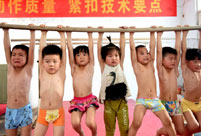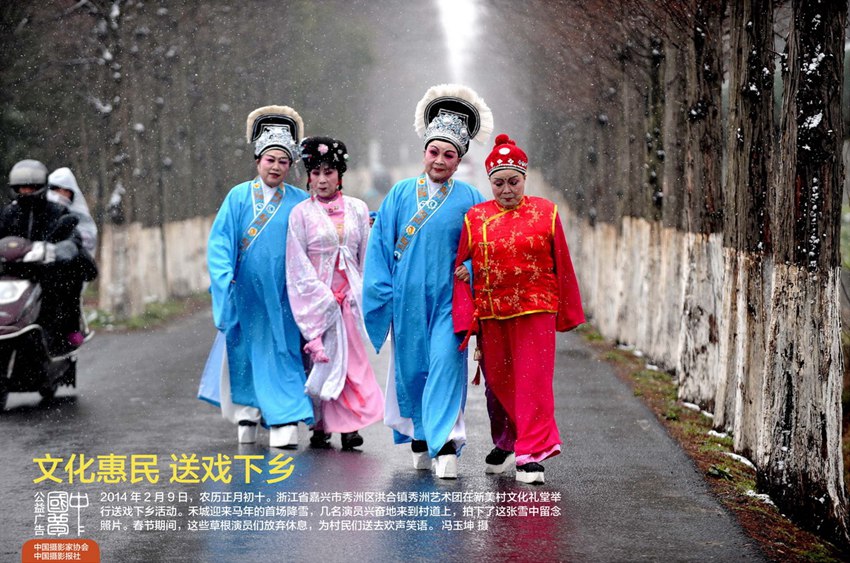 The 4th Chinese National Pole Dance Championship held in Tianjin
The 4th Chinese National Pole Dance Championship held in Tianjin
 Chinese navy commandos debut at 2014 RIMPAC
Chinese navy commandos debut at 2014 RIMPAC
 Guangxi impression: scenic countryside
Guangxi impression: scenic countryside
 World's largest aquatic insect found in Sichuan
World's largest aquatic insect found in Sichuan
 Ceremony volunteers for Youth Olympics make public appearance
Ceremony volunteers for Youth Olympics make public appearance
 A glimpse of female crew of Liaoning aircraft carrier
A glimpse of female crew of Liaoning aircraft carrier
 Stills from "Dad, where are we going?"
Stills from "Dad, where are we going?"
 Legless man's happy life
Legless man's happy life
 Top ten most beautiful islands in China
Top ten most beautiful islands in China
 Aerial view of Hong Kong
Aerial view of Hong Kong
BEIJING, July 24 -- As China shifts its focus to a more balanced development model, gross domestic product (GDP) growth is decelerating in many parts of the country.
According to figures released by Hebei Provincial Bureau of Statistics (HPBS) on Wednesday, GDP growth of north China's Hebei Province in the first half of 2014 increased by 5.8 percent. But this was dwarfed by the 8.7 percent growth rate over the same period last year.
Hebei, which borders Beijing, has been trying to cut polluting facilities such as cement, steel and glass, the major powerhouses driving its economy, as the province is partly blamed for smog that has blanketed the Chinese capital.
"In the first six months, we have seen a 1.6 percent increase of the tertiary industry and a 1.5 percent decrease of the secondary industry in terms of GDP proportion," said Yang Jingxiang, deputy head of the HPBS.
A similar situation can be found in Beijing, which reported 7.2 percent GDP growth in the first two quarters, falling short of the 7.7 percent expansion recorded from January to June in 2013.
Beijing closed the Gaojing Thermal Power Plant, a subsidiary of the state-owned China Datang Corporation, on Wednesday, replacing it with a gas-fired facility to curb pollution. Three other coal-fired power plants are expected to be closed by the end of 2016.
Other provinces and regions, including Guangxi, Guangdong and Jiangxi, all reported slower GDP expansion in the first two quarters, as China drops the growth-at-all-costs economic development model that has tainted the country's air, water and soil.
Local level authorities are encouraging primary and tertiary industries, hoping they achieve sound economic growth. Gradual changes are steering the country's economic development toward a more sustainable one.
GDP NO LONGER SOLE INDICATOR
Big polluting industries helped power China's GDP growth over the last decade. But the environment was largely compromised, as factories constantly coughed out black smoke and discharged polluted water.
Efforts to address environmental concerns have remained lacklustre as local governments supported polluting industries to generate economic growth to meet targets.
The Chinese government adopted a new appraisal system towards officials last year, stipulating that their evaluation should be based on environmental protection, the ecosystem, tackling overcapacity, service industries, among other areas, instead of purely on economic figures.
The move prompted local level governments to rethink development models and lower their GDP targets while making structural changes.
In Tiannan County in east China's Jiangxi Province, agriculture used to prop up growth. But before GDP targets were lowered the county introduced three ceramic factories and a non-ferrous metal processing plant, fouling the environment.
"If we didn't develop these industries, our GDP would have remained near the bottom in evaluations," said Sheng Hengda, secretary of the Tiannan County Committee of the Communist Party of China.
But now that the country has eased GDP pressure on local officials, the county has seen its surroundings improve significantly, Sheng told Xinhua.
"We have equipped the factories with pollution-treating facilities," he added.
In southwest China's Sichuan Province, the provincial government has split cities and counties into different groups for evaluation. According to a regulation published on June 27, 58 counties with good eco-systems are now exempt from GDP assessment, with their future evaluation based on forest acreage and the poverty rate.
QUALITY DEVELOPMENT
As the growth-driven evaluation system loses momentum, places are aiming at quality development models by supporting the tertiary industry and improving people's livelihoods in environment-friendly ways.
In the first half of 2014, Beijing closed 213 polluting companies. In addition, sectors such as information technology, financial services and high technology exceeded 50 percent of the city's GDP growth in the January-June period.
From January to May, six high-tech sites in Beijing, including Zhongguancun Science and Technology Park, achieved a 10.1 percent income increase, making up more than 90 percent of the city's hi-tech manufacturing income.
At the same time, northwest China's Xinjiang Uygur Autonomous Region shifted its focus from GDP to ecological protection.
"Although the overall GDP growth rate went down, the government now has more time to protect the environment, and to transform the development model. It will be healthy in the long-run," said Zhao Hong, vice president of Beijing Academy of Social Sciences.
 Zhujiang ambassadors attend lotus lanterns activity
Zhujiang ambassadors attend lotus lanterns activity
 From girly girl to tough special police officer
From girly girl to tough special police officer
 Children attend gymnastics training in summer
Children attend gymnastics training in summer
 Beautiful sceneries along the special travel route in Xinjiang
Beautiful sceneries along the special travel route in Xinjiang
 Focus on 1st female patrol team in Turpan
Focus on 1st female patrol team in Turpan
 Collection of 'China Dream' public-spirited ads
Collection of 'China Dream' public-spirited ads  National fitness team members integrate traditional and modern beauty
National fitness team members integrate traditional and modern beauty Moms on their kid’s coming out
Moms on their kid’s coming out Chinese fighters through lens
Chinese fighters through lens
 48 hours after super Typhoon Rammasun
48 hours after super Typhoon Rammasun Bikini show held at water park in Xi'an
Bikini show held at water park in Xi'an
 Lobster vs cat: catch me if you can
Lobster vs cat: catch me if you can  Heat waves sweep China
Heat waves sweep China  Top 10 most beautiful islands in China
Top 10 most beautiful islands in China
 Zhou Xun announces engagement to Archie Gao
Zhou Xun announces engagement to Archie Gao
Day|Week|Month